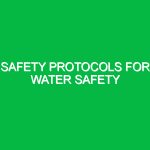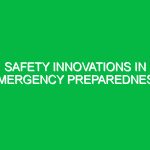Understanding Emergency Preparedness in Facility Management
Emergency preparedness for facility management plays a crucial role in the health, safety, and environment (HSE) domain. It encompasses strategies and practices designed to prepare facilities for various emergencies, ranging from natural disasters to man-made incidents. The goal is straightforward: protect lives, safeguard property, and ensure business continuity. In an age where disruptions can arise unexpectedly, effective emergency preparedness is not just advisable; it is essential.
Imagine a bustling office building during a sudden fire alarm or an unexpected flood threatening critical infrastructure. The reactions of facility managers and their teams can mean the difference between chaos and calm. Emergency preparedness involves comprehensive planning, training, and response protocols tailored to the unique risks associated with different facilities. This article explores the potential hazards, safety precautions, best practices, and regulatory frameworks essential for effective emergency preparedness in facility management.
Identifying Potential Hazards and Risks
Understanding the variety of hazards is the first step in preparing for emergencies. Each facility may face its specific risks based on location, function, and design. Here are some common categories of hazards that facility managers must consider:
Natural Disasters
Natural disasters like earthquakes, floods, hurricanes, and wildfires can have devastating effects on facilities. For instance, a hurricane can lead to extensive property damage and prolonged power outages. Facilities located in flood-prone areas must have robust drainage systems and elevated structures to mitigate risks.
Technological Hazards
Technological hazards include incidents stemming from equipment failures or cyber-attacks. A malfunctioning HVAC system can result in unhealthy air quality, while a cyber breach can expose sensitive data. For example, in 2020, a cyber attack on a water treatment facility in Florida underscored the vulnerability of critical infrastructure.
Human-Caused Events
Human-caused emergencies, such as workplace violence, theft, or terrorism, pose significant risks. Facilities need to implement security protocols, including access control systems and surveillance cameras, to deter potential threats. A notable case is the 2016 Pulse nightclub shooting, which highlighted the need for emergency response plans in public spaces.
Health Emergencies
Pandemics and health-related emergencies, such as the COVID-19 outbreak, have reshaped the landscape of emergency preparedness. Facilities must now integrate health protocols, including sanitation measures and social distancing guidelines, into their emergency plans.
Safety Precautions and Best Practices
Once potential hazards have been identified, the next step is implementing safety precautions and best practices. Here are actionable strategies for facility managers:
Develop Comprehensive Emergency Plans
Every facility should have a well-documented emergency response plan that outlines procedures for different scenarios. This plan should include evacuation routes, communication protocols, and designated roles for staff during an emergency. Regularly reviewing and updating the plan ensures it remains relevant.
Conduct Regular Training and Drills
Training staff is essential for effective emergency preparedness. Regular drills help familiarize everyone with emergency procedures and build confidence in their roles. For instance, a facility manager could organize quarterly fire evacuation drills that simulate real-life scenarios, allowing staff to practice their response.
Establish Communication Channels
Clear communication is vital during emergencies. Facility managers should establish reliable communication channels, such as public address systems, text alerts, or dedicated apps, to disseminate information quickly. For example, during the COVID-19 pandemic, many organizations used mobile apps to keep staff informed about health guidelines and facility status.
Invest in Emergency Supplies
Having the right supplies on hand can significantly impact response efforts. Facilities should stock essential emergency supplies, including first aid kits, flashlights, batteries, water, and non-perishable food items. Regularly checking and replenishing these supplies ensures readiness.
Collaborate with Local Authorities
Building relationships with local emergency services can enhance preparedness efforts. Facility managers should engage with local fire departments, police, and health officials to understand community resources and response strategies. For example, participating in community preparedness workshops can provide valuable insights into local risks and response capabilities.
Regulatory Frameworks Governing Emergency Preparedness
Compliance with regulations and standards is a cornerstone of emergency preparedness for facility management. Various organizations and governmental bodies provide guidelines that facilities must adhere to:
Occupational Safety and Health Administration (OSHA)
OSHA sets forth standards for workplace safety, including emergency preparedness. Facilities are required to develop emergency action plans (EAPs) that outline procedures for evacuations, medical emergencies, and hazardous materials incidents.
National Fire Protection Association (NFPA)
The NFPA provides guidelines for fire safety and emergency response. Their codes, such as NFPA 101 (Life Safety Code), outline requirements for means of egress, fire alarms, and suppression systems. Following these guidelines helps ensure facilities are equipped to handle fire-related emergencies effectively.
Federal Emergency Management Agency (FEMA)
FEMA offers resources and training for facility managers to enhance emergency preparedness. Their guidelines encourage the development of comprehensive emergency plans and emphasize the importance of community engagement.
Building Codes and Local Regulations
Local building codes and regulations may impose specific requirements related to emergency preparedness. Facility managers must stay informed about these regulations and ensure compliance to avoid legal repercussions and ensure safety.
Creating a Culture of Preparedness
Emergency preparedness is not solely the responsibility of facility managers; it requires a collective effort from all staff. Creating a culture of preparedness involves ongoing training, open communication, and fostering an environment where safety is prioritized. Encourage employees to participate in safety committees or training sessions, and reward proactive behavior related to preparedness.
A personal anecdote from a facility manager I spoke with illustrates this point. During a severe weather warning, their team had conducted drills that emphasized communication and preparedness. When the storm struck, employees knew their roles, and the facility experienced minimal disruption. This success was attributed to the culture of preparedness cultivated over time.
Conclusion: The Path Forward in Emergency Preparedness
Emergency preparedness for facility management is an ongoing journey. By understanding potential hazards, implementing safety precautions, adhering to regulations, and fostering a culture of preparedness, facility managers can significantly mitigate risks and enhance safety.
In an unpredictable world, the ability to respond effectively to emergencies not only protects lives but also ensures the resilience of facilities. As you take steps in your own facility, remember that preparedness is not a one-time effort but a continuous commitment to safety and well-being. Every drill, every training session, and every conversation about safety contributes to a stronger foundation for emergency preparedness.
In the end, the most effective emergency preparedness plans are those that are practiced, refined, and embraced by everyone in the organization. Take the initiative, stay informed, and prepare to safeguard what matters most.


